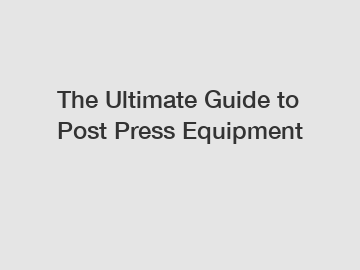Dec. 12, 2023
Machinery
The Ultimate Guide to Post Press Equipment: What Should You Know?
Post press equipment plays a crucial role in the printing industry, ensuring the final touches are perfect and the product is ready for distribution. But with a wide array of equipment available, it can be overwhelming to understand which ones are essential for your printing operations. In this comprehensive guide, we will explore the different types of post press equipment, their functions, and how they contribute to the overall quality of the printed materials.
1. Folding Machines:

Folding machines are indispensable when it comes to creating neat and precise folds in documents such as brochures, flyers, and letters. They help enhance the visual appeal of the printed materials and enable easy handling. From simple single-fold options to complex multi-fold capabilities, folding machines come in various configurations to suit your specific needs.
2. Binding Machines:
Binding machines are essential for joining multiple pages together to create books, catalogs, or reports. There are different types of binding available, including coil binding, comb binding, and perfect binding. Each method has its own advantages and suitable applications. Coil binding provides flexibility and allows the pages to lie flat, while comb binding allows for easy editing and adding/removing pages. Perfect binding, on the other hand, gives a professional and polished look to thicker publications.
3. Laminating Machines:
Laminating machines are responsible for adding a protective layer to printed materials, making them resistant to moisture, tearing, and other damage. Whether you want to preserve important documents, create durable ID cards, or enhance the longevity of promotional materials, laminating machines are ideal for achieving a professional finish. They come in different sizes and can handle various thicknesses, offering flexibility for different types of projects.
4. Cutting Machines:
Further reading:Cutting machines are used to trim printed materials to the desired size and create clean edges. They are available in manual, semi-automatic, and fully automatic options, catering to different production volumes and precision requirements. Guillotine cutters and paper trimmers are commonly used, with advanced models equipped with digital displays and programmable settings for increased efficiency.
5. Collating Machines:
Collating machines ensure that the printed materials are accurately assembled in the correct order. They save considerable time and effort compared to manual collation, especially when dealing with high volumes. Whether it's a multipage report or a set of leaflets, collating machines simplify the process of organizing and arranging the pages, eliminating manual errors.
6. Numbering Machines:
Numbering machines are crucial for applications that require unique identifications such as invoices, tickets, or forms. They automate the process of adding sequential numbers to individual sheets and can also include other information like dates or barcodes. These machines are highly efficient and ensure accuracy, reducing the risk of manual errors while maintaining consistency in numbering.
7. Perforating Machines:
Perforating machines create small holes or slits in printed materials, allowing easy tear-off or separation. They are commonly used for applications like coupons, tickets, or reply cards that require a detachable section. These machines come in various designs, offering flexibility in terms of hole or slit size, pattern, and placement.
In conclusion, understanding the different types of post press equipment and their functions is vital for ensuring a high-quality end product in the printing industry. Folding machines, binding machines, laminating machines, cutting machines, collating machines, numbering machines, and perforating machines each play a specific role in enhancing the visual appeal, durability, and efficiency of printed materials. By investing in the right equipment based on your specific requirements, you can streamline your printing operations and deliver exceptional results to your clients. So, what are you waiting for? Explore the world of post press equipment and take your printing business to new heights!
If you want to learn more, please visit our website Paperboard Die Cutting Machine, Small Format Die Cutter, Gravure Printing Machine.
Further reading:Previous: How does a tube straightener work?
Related Articles
If you are interested in sending in a Guest Blogger Submission,welcome to write for us!
All Comments ( 0 )